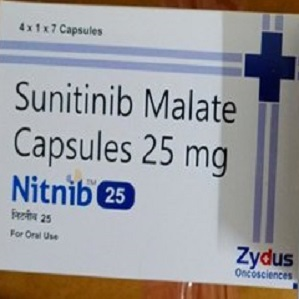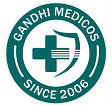Nitnib 25 for GISTs
Cancerous cells can be formed in almost any area in the human body and subsequently spread to other regions. GISTs, also known as digestive tract tumors, are rare malignancies that begin in specific cells in the gut lining. The GI tract breaks down food to provide energy and eliminates solid waste from the body. Following a predetermined route, food enters the body through the mouth, esophagus, small intestine, and large intestine before entering the stomach. Cajal’s interstitial cells, which are unique in the GI tract wall, are where gastrointestinal stromal tumours (GISTs) begin in their earliest stages.
Because they tell the GI tract’s muscles to contract to transport solid and liquid along, ICCs are frequently referred to as the “pacemakers” of the digestive system. Stomach GISTs account for more than fifty per cent of cases. GISTs can begin anywhere throughout the GI tract, unlike most other cancers, which often begin in the small intestine. A small percentage of GISTs begin outside the GI tract in surrounding areas such as the peritoneum or the omentum, a fatty layer draping over the organs like an apron.
Causes
Some GISTs appear to be far more prone than others to disseminate to other regions of the body or grow into new locations. To determine if a GIST is likely to expand and spread quickly, doctors consider various characteristics, including the tumor’s size, its location of it within the GI tract, and the tumor cells’ mitotic rate, which is the rate at which they divide.
Although the etiology of most gastrointestinal stromal tumors is unknown, significant progress has been made in understanding how certain DNA mutations can turn healthy cells into cancerous cells. It appears to be connected to a KIT protein’s expression change. Typically, this gene is dormant, but when this gene is mutated, the cells constantly divide and develop, resulting in this cancer. There are currently just a few identified major risk factors for gastrointestinal stromal tumors, such as age greater than 50 and genetic syndrome inheritance. However, having one or more risk factors does not guarantee that an individual will develop the disease. Additionally, many individuals who get the illness might have little or no established risk factors.
Treatment
 Whether a tumor can be physically eradicated or if cancer has spread to other organs in your body will determine your treatment options for GIST. There are two common approaches to treating GIST. Surgery being the first. A medical expert may do surgery to remove the tumor and some surrounding tissue if the GIST hasn’t spread and it’s safe to do so. A laparoscope, a narrow, illuminated tube, may be utilized to create incisions and remove tissues.
Whether a tumor can be physically eradicated or if cancer has spread to other organs in your body will determine your treatment options for GIST. There are two common approaches to treating GIST. Surgery being the first. A medical expert may do surgery to remove the tumor and some surrounding tissue if the GIST hasn’t spread and it’s safe to do so. A laparoscope, a narrow, illuminated tube, may be utilized to create incisions and remove tissues.
The second-best choice is targeted therapy, which is carried out with a unique medication. One illustration of this kind of medication is Nitnib 25. Manufactured by Zydus Cadila. It has a salt composition of Nitnib 25(Sunitinib malate capsules). Nitnib 25 capsule cancer-fighting drug functions by attaching to and inhibiting particular cell surface proteins like (tyrosine kinase) that promote the growth of particular cells.
Additionally, blood vessel growth in tumors also gets hampered. There are a few negative effects that this medicine may cause, including nausea, vomiting, weakness, rashes, abdominal discomfort, and indigestion. Therefore, it is crucial to take it as directed by your doctor. Nitnib 25 can be consumed with or without food. However, for the best results, Nitnib 25 should be consumed at the same time each day. All the other safety precautions should be taken while using this specific prescription, like avoiding consumption by females who are breastfeeding.


 Anti Cancer Drugs
Anti Cancer Drugs Hepatitis C
Hepatitis C Meds for HIV
Meds for HIV Ayurvedic Medicine
Ayurvedic Medicine Transplant Medicine
Transplant Medicine Respiratory System
Respiratory System +91-9811604444/ 9811604424/ 9999064250
+91-9811604444/ 9811604424/ 9999064250  8(800)100-47-90
8(800)100-47-90
